- Author Jason Gerald [email protected].
- Public 2023-12-16 10:50.
- Last modified 2025-01-23 12:04.
Asking is a basic way to gather information. But like everything else, it takes skill to do it well. Asking open-ended questions is a friendly way to engage people in conversation. Knowing the difference between open and closed questions will really help you in your career as well as socializing.
Step
Part 1 of 2: Understanding Open Questions
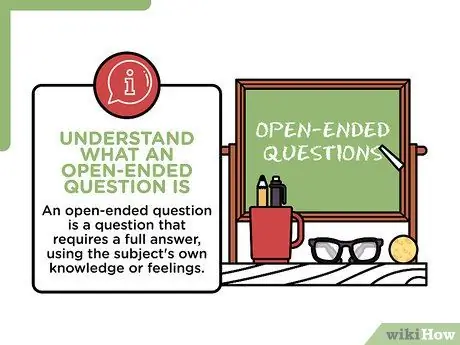
Step 1. Know what an open-ended question is
Before you can start asking open-ended questions effectively, you need to know what open-ended questions are. Open-ended questions are questions that require a full answer using the subject's own knowledge or feelings. Open-ended questions are objective, do not direct the person being asked, and produce a multi-word answer. Examples of open questions:
- "What happened after I left?"
- "Why did Jimmy leave before Sarah?"
- "What do people think of the cake?"
- "Tell me about your job today."
- "What do you think about the new season of the TV show?"
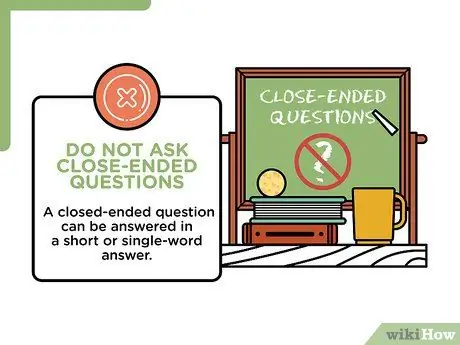
Step 2. Don't ask closed questions
Closed questions are answered with short or one-word answers. Closed questions are used to obtain only certain facts and pieces of information. Examples of closed questions:
- "Who will you choose?"
- "What's the brand of your car?"
- "Have you talked to Budi?"
- "Did Sarah leave Jimmy?"
- "Have you eaten all the cakes?"
- Closed questions stop the conversation. Closed questions do not invite people to explain, tell about themselves, or give the questioner any information about the answerer.
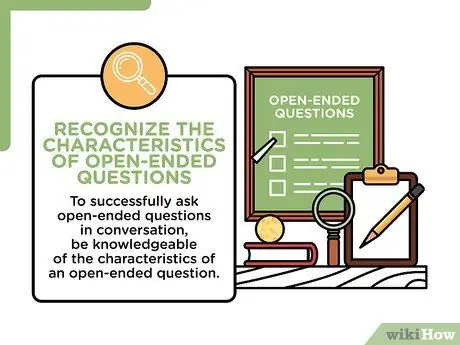
Step 3. Identify the characteristics of open-ended questions
Sometimes, people think the questions they are asking are open-ended questions, but they are not. To be able to ask open-ended questions properly in a conversation, know the characteristics of open-ended questions.
- Open-ended questions make the answerer need to pause, think, and reflect.
- The answers obtained will not be facts, but personal feelings, opinions, or ideas regarding the subject of the question.
- When using open-ended questions, the conversation handler switches to the person being asked, which initiates a conversation between two people. If the conversation controller remains with the questioner, it means that the question is a closed question. The second technique is more like an interview or interrogation than a conversation.
- Avoid questions that have the following characteristics:
- The answer is a fact;
- Easy to answer;
- Can be answered quickly and requires almost no thought. Questions like these are closed questions.
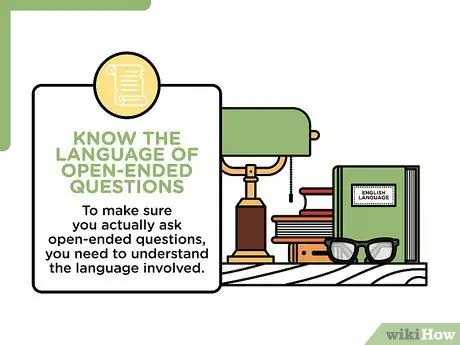
Step 4. Identify the language style used in open-ended questions
To ensure that the questions asked are open-ended questions, understand the language used. Open-ended questions begin in a very specific way.
- Open-ended questions begin with the following words: "why", "how", "what", "describe", "tell me about…", or "what do you think about…"
- Even though “tell me about” is not in the form of a question sentence, the result is the same as asking an open-ended question.
- Closed questions also use specific language. If you want to avoid closed questions, don't start the question with the following words: "whether", "would", "wouldn't", "would" (in English: is/am/are/was/were, did, will, won 't, didn't, aren't, would, if, etc.).
Part 2 of 2: Using Open Questions
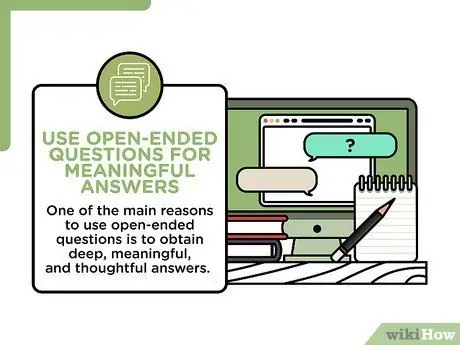
Step 1. Use open-ended questions to get meaningful answers
One of the main reasons for using open-ended questions is to get deep, meaningful, and thoughtful answers. Asking open-ended questions invites people to open up, because it shows that you are interested in what they think.
- Don't use closed questions when you want a meaningful answer. Closed questions stop the conversation. One-word answers make it difficult for you to build a conversation or relationship with the person in question. Closed questions usually don't provide sufficient answers either.
- Use open-ended questions when you want detailed explanations.
- Use open-ended questions to expand the conversation after asking closed questions that provide a fact or one-word answer. Get answers in the form of facts or one word, and build complete conversations from those facts using open-ended questions.
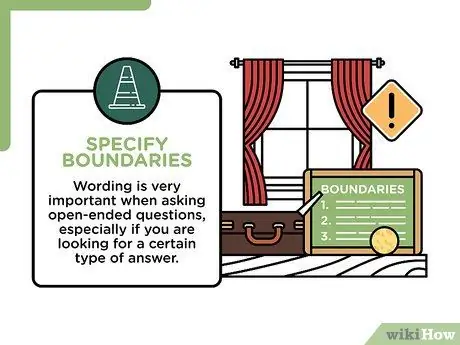
Step 2. Define boundaries
Open-ended questions are sometimes too broad. Word choice is very important when asking open-ended questions, especially if you want a specific answer.
If you want to find a boyfriend for a friend, you might ask, “What kind of person do you like?” Friends may give answers in the form of physical characteristics, when you want answers in the form of personality. Instead, ask more specific questions with measurable “guidelines,” such as: “What kind of personality do you like?”
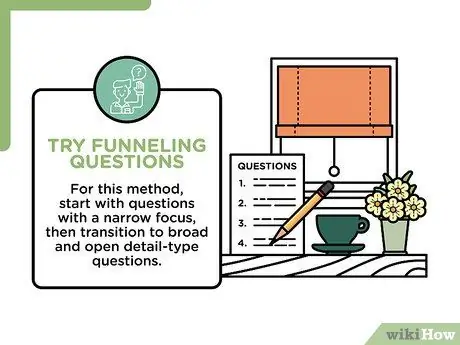
Step 3. Try to direct the question
To use this method, start with narrow questions, then use broad, open-ended questions. This method is great for getting specific details from a person. In addition, this method can also be used to make someone become interested in a topic, or make someone more confident.
If it's difficult to get someone to open up to broad open-ended questions, try using narrower questions first, then using broader questions after the conversation. For example, when talking to your children. You may ask, "What happened at school today?" “None” is likely the answer. Follow up with questions like, “What writing assignment are you working on?” Most likely, the question will spark further conversation
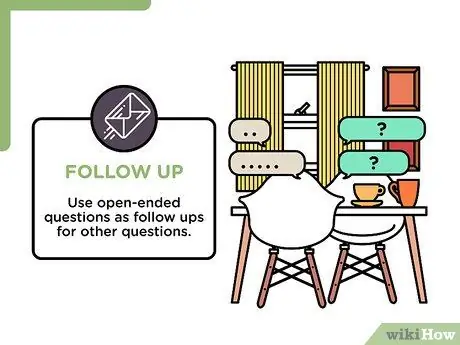
Step 4. Follow-up questions
Use open-ended questions as a continuation of other questions. Follow-up questions can be asked after open or closed questions.
- Use “why” and “how” questions as follow-up questions to get a longer answer after asking closed questions.
- After someone has finished speaking, ask open-ended questions that refer to, or relate to, what he or she just said. It keeps the conversation flowing openly and actively.
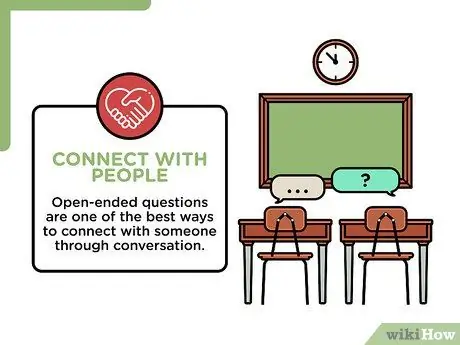
Step 5. Connect with people
Open-ended questions are one of the best ways to connect with someone through conversation. Unlike closed questions, open questions encourage deeper and meaningful interactions between two people. Open-ended questions indicate that the questioner is interested in listening to the answerer's response.
- Use open-ended questions to find out more about a person. Often, open-ended questions encourage people to talk about themselves. By asking follow-up questions, you can continue to learn more about the person.
- Open-ended questions can demonstrate concern, affection, or anxiety for someone. Open-ended questions require more personal and in-depth answers. By asking “How are you feeling?” or “Why are you crying?”, you invite people to express their feelings. Asking, "Are you all right?" requires only “yes” or “no” answers.
- Use open-ended questions to start a conversation with a quiet, nervous, or new person. This can help them feel calmer and encourage them to open up.
- Use open-ended questions if you don't want to force, trap, or influence someone's answer. Most open-ended questions are neutral. The words used in closed questions cause people to feel compelled to give certain answers. For example, a leading question might be, "Don't you think this dress is beautiful?", while a neutral open-ended question would be something like, "What do you think about this dress?" Tail questions such as “no?”, “yes no?”, or “can't they?” can turn a question into a leading question, as it suggests that the person you are talking to agrees with you. Don't use question tails on open-ended questions.
- Be careful not to ask questions that are too personal or require too much personal information. Consider the answerer's comfort level when asking questions. If the question is too personal, replace it with another question that is less personal.
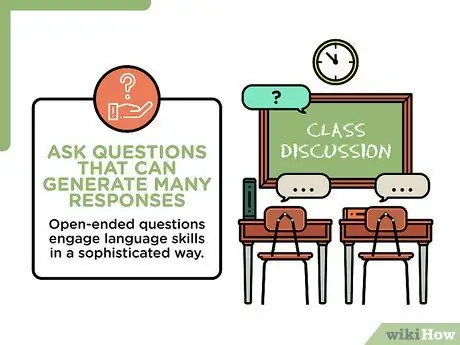
Step 6. Ask a question that has many possible answers
Open questions are great for discussion. Open-ended questions encourage different answers, opinions, and solutions, as well as creative thinking and checking the validity of one's ideas.
Open-ended questions involve subtle language skills. Open-ended questions can be used to interact with children and new language learners to help stimulate their minds and improve their language skills
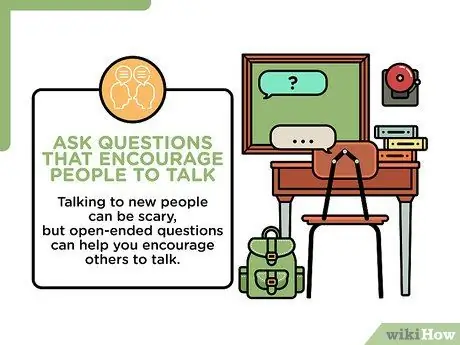
Step 7. Ask questions that encourage people to talk
Conversation is a difficult art for many people. Talking to new people can be daunting, but open-ended questions can help you encourage others to talk.
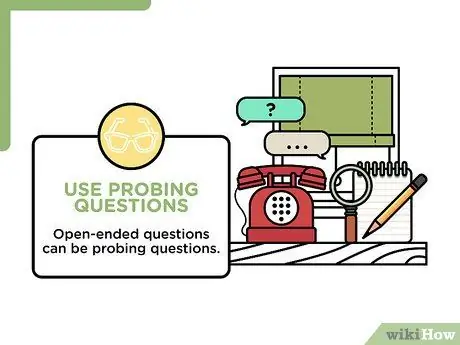
Step 8. Use open-ended questions to provoke further explanation
Open questions can be angler questions. There are two different methods for asking anglers questions:
- Fishing for clarity. If asking an open-ended question that results in a general answer, add another open-ended question for clarity. For example, if you ask, “Why do you like living here?” and answered, “Because the view is good.”, additional questions to clarify the answer can be asked, such as, “Which view?”
- Fishing equipment. Once clear and complete answers have been provided as a result of the open-ended questions, other questions can be asked to obtain additional information. Examples of questions that provoke complete answers include “What else do you like?” or “What other reasons do you have?”
- Don't use the question "Anything else?" It's a closed question, and runs the risk of producing a simple "no" answer.
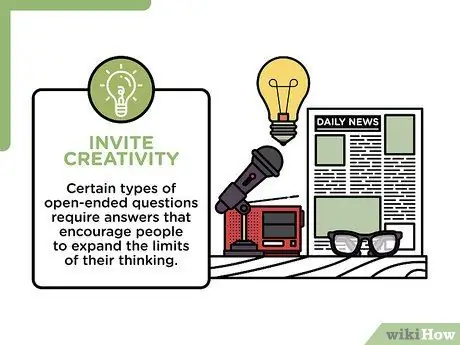
Step 9. Trigger the creativity of the answerer
One of the results of open-ended questions is creativity. Certain types of open-ended questions require answers that push people to think beyond boundaries.
- Some open-ended questions require prediction. Questions like, “Who will win the election?” or “What will happen to our country with the election of this candidate?” requires people to think of various possible scenarios.
- This type of question sometimes also makes people consider the consequences of something. By asking, “What would happen if…” or “What would happen if you…”, you invite people to think about the cause and effect of the scenario being asked.
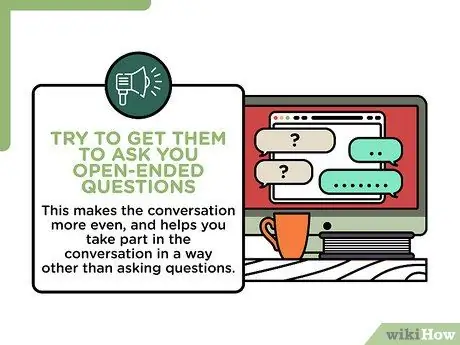
Step 10. Try getting the other person to ask you open-ended questions
That will make the conversation more balanced, and help you take on other parts of the conversation, apart from just being the questioner. To get people to question you, try not to give all the details of the story or opinion right away.
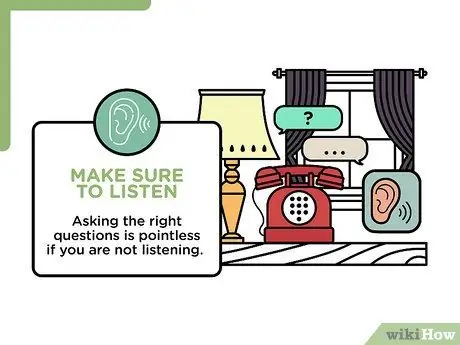
Step 11. Be sure to listen
Asking the right questions is useless if you don't listen. Sometimes, we make the mistake of structuring the next question without paying attention to the answer to the first question. You're missing out on a good opportunity to ask follow-up questions if that happens. Try to listen to the answers to the questions you ask.
Warning
- People who answer open-ended questions uncomfortably may not understand where you're leading the conversation or don't really want to answer. Try to give a little explanation. If the person still refuses, the answer may be personal or a topic that he or she doesn't want to talk about.
- Open-ended questions can lead to long, verbose answers. If you want a short or relevant answer, be sure to ask a fairly specific question.






